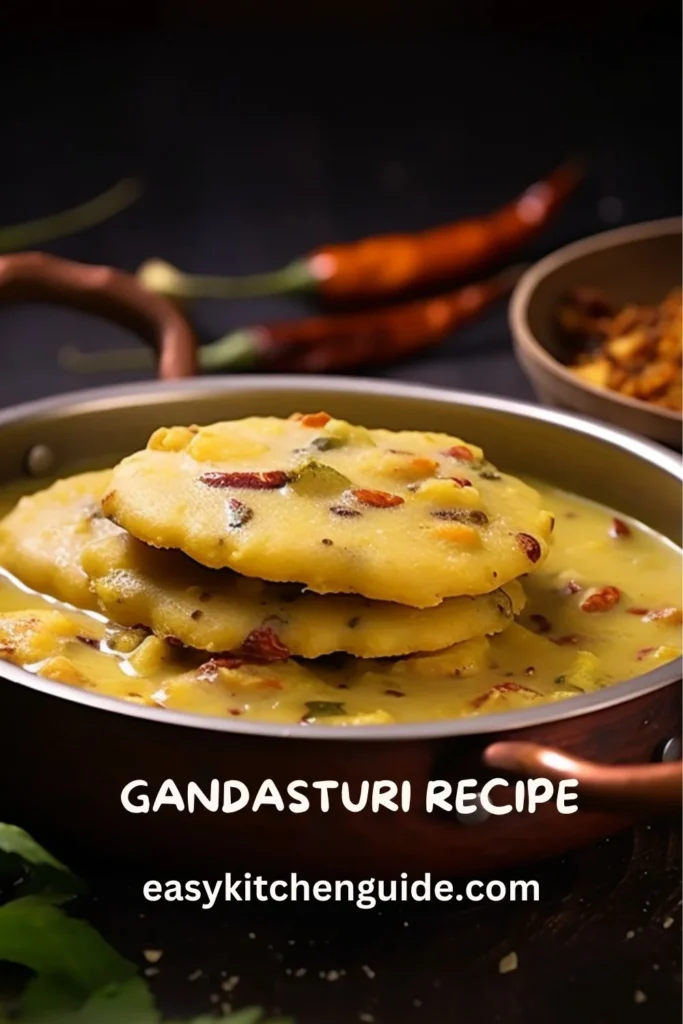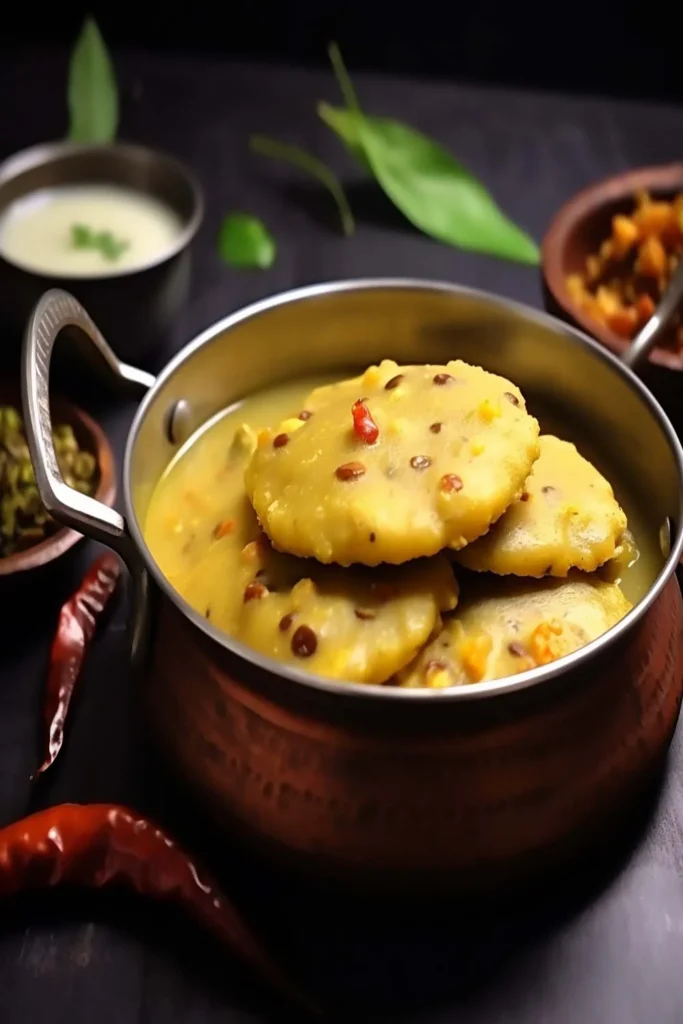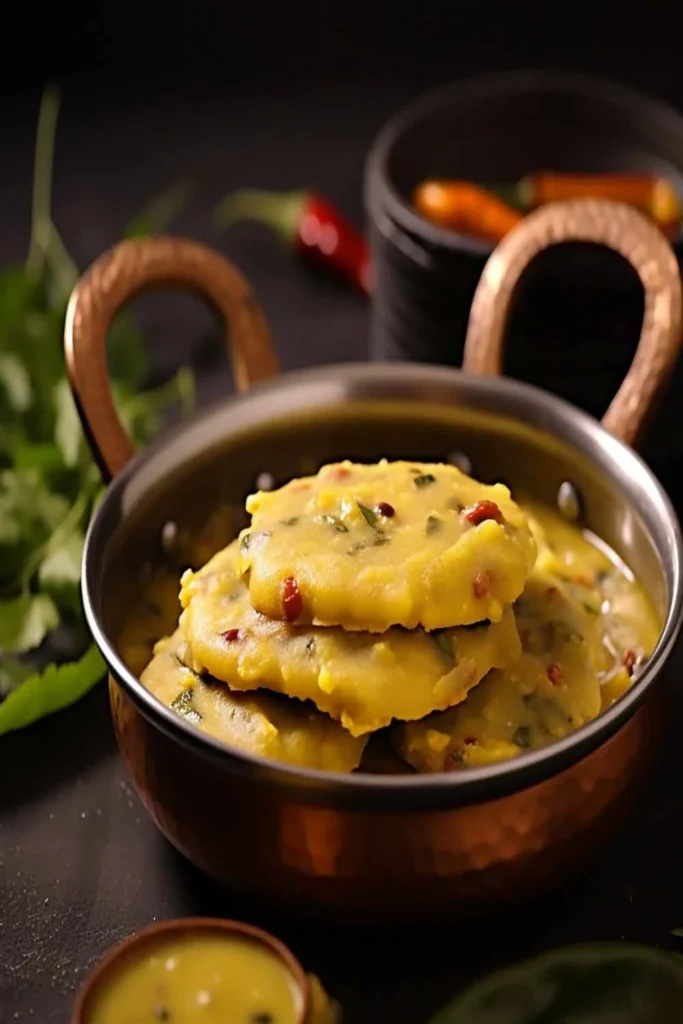Gandasturi, a mouth-watering delicacy from the heart of Indonesia, is a gem that beautifully encapsulates the rich and diverse culinary tradition of this Southeast Asian country. This traditional snack, often enjoyed during festive celebrations or as a casual treat, features a dreamy combination of mung beans and creamed coconut encased in a crisp dough made from all-purpose and rice flour.
The unique addition of pandan leaves brings a sweet, floral fragrance that’s both comforting and tantalizing. Each bite of Gandasturi offers a delightful contrast of textures – the crispy outer layer giving way to a soft, sweet, and rich filling. Making Gandasturi at home is an experience in itself, a journey through the authentic flavors of Indonesia.
So, roll up your sleeves and get ready to dive into the art of making Gandasturi!

What is Gandasturi?
Gandasturi, also known as ‘Pandan Mochi’ or ‘Pandan Glutinous Rice Cake’, is a traditional Indonesian snack that originated from the island of Java. It is made by filling a dough shell with a mixture of sweetened mung beans and creamed coconut, and then steaming or frying it to perfection.
This delicious treat is popular not only in Indonesia but also in other Southeast Asian countries like Malaysia, Singapore, and Brunei. It is often served during special occasions such as weddings, birthdays, and religious festivals like Eid al-Fitr.
Why You’ll Love This Gandasturi?
There are countless reasons to love Gandasturi. The flavors, textures, and aroma of this snack are simply irresistible. But beyond that, making Gandasturi is a cultural experience in itself. As you prepare this delightful treat, you will be transported to the vibrant streets of Indonesia with its bustling food markets and rich culinary heritage.
Moreover, Gandasturi is made with simple and wholesome ingredients, making it a healthier alternative to many store-bought snacks. The combination of mung beans and coconut also provides a good source of protein and healthy fats.
You’ll also like the following Dinner recipes!
- Waffle House Patty Melt
- Gordon Ramsay’s Ratatouille Copycat Recipe
- How to Make Marie Callender Pie Crust Recipe
The Ingredients
- All-purpose flour and rice flour: These are the fundamental ingredients for the dough of the Gandasturi. They provide the necessary structure and texture to the snack.
- Salt: Salt is a crucial ingredient in both sweet and savory recipes. It enhances the flavors of other ingredients and can balance the sweetness in the recipe.
- Oil: Oil is used in the dough to provide moisture and prevent it from drying out. It also helps in frying the Gandasturi, giving it a golden brown color and a crisp texture.
- Pandan leaves: Pandan leaves are essential for adding a unique aroma and flavor to the Gandasturi. They’re often used in Indonesian cuisine for their sweet, floral fragrance.
- Mung beans: Mung beans are the primary filling in Gandasturi. They are high in protein and give a satisfying bite to the snack.
- Creamed coconut: This adds richness and a subtle sweetness to the filling. It also contributes to the unique flavor profile of the Gandasturi.
- Vanilla powder: Vanilla is a common flavor enhancer in many sweet dishes. In Gandasturi, it adds a layer of flavor to the filling.
- Raw cane sugar: This sweetens the mung bean filling. Raw cane sugar has a slight caramel-like taste that adds depth to the overall flavor.
- Water: Water is vital in this recipe as it’s used in different stages – to make the dough, cook the mung beans, and mix the rice flour for the final coating.

Step by Step Instructions
Step 1: Make the Dough
- In a mixing bowl, combine the all-purpose flour, rice flour, a pinch of salt, and a drizzle of oil.
- Gradually add water to the dry ingredients while stirring.
- Knead the mixture diligently until it transforms into a smooth and elastic dough.
- Cover the dough with a damp cloth, ensuring it’s completely sealed, and let it rest for approximately 30 minutes. This resting period allows the dough to relax and become more pliable.
Step 2: Prepare the Filling
- Take a pot and add mung beans along with enough water to cover them.
- Cook the mung beans until they become soft and easily mashable. This may take around 20-30 minutes.
- Mash the cooked mung beans into a paste-like consistency.
- In a separate pan, set the heat to low and combine creamed coconut, raw cane sugar, a dash of vanilla powder, and a pinch of salt.
- Stir the mixture over low heat until it becomes well-blended and slightly thickened.
- Incorporate the mashed mung beans into the coconut mixture and continue to cook, stirring constantly, until the filling thickens further. This could take a few minutes. Once done, set the filling aside.
Step 3: Roll Out the Dough
- After the 30-minute resting period, your dough should be ready.
- Sprinkle some flour on a clean surface to prevent sticking, and place the dough on it.
- Roll out the dough into thin sheets using a rolling pin. Aim for a thickness of about 2-3 millimeters.
- Using a cookie cutter or any round object with a diameter of approximately 2-3 inches, cut out small circles from the rolled dough. These will serve as the wrappers for your Gandasturi.
Step 4: Add the Filling
- Place a spoonful of the mung bean and coconut mixture in the center of each dough circle. Ensure not to overfill, as it might make sealing the edges difficult.
Step 5: Fold and Seal
- Carefully fold the edges of the dough over the filling, creating a half-moon shape.
- Press down on the edges with a fork to seal them securely. This helps prevent the filling from leaking during cooking.
Step 6: Steam or Fry
Option A – Steaming:
- If you prefer steamed Gandasturi, place them in a steamer and steam for approximately 20 minutes or until the dough is fully cooked and the Gandasturi are firm.
Option B – Frying:
- If you’d like to fry the Gandasturi, heat the oil over medium heat.
- Gently place the prepared Gandasturi in the hot oil.
- Fry them for about 2-3 minutes on each side or until they turn golden brown and crispy.
- Once fried, remove them from the oil and place them on a paper towel to drain any excess oil.
Step 7: Serve and Enjoy
- Before serving, you can garnish your Gandasturi with shredded coconut or sesame seeds for added flavor and visual appeal.
- Enjoy your delicious Gandasturi either hot or at room temperature.
Notes
- For a gluten-free option, use only rice flour or substitute with gluten-free all-purpose flour.
- If you can’t find pandan leaves, you can use pandan extract for the same aroma and flavor.
- To make a healthier version of Gandasturi, try baking it instead of steaming or frying. Simply brush some oil on top of the dough before baking at 375°F for about 20 minutes.
- To make the filling more creamy, you can add a little bit of coconut milk to the mixture while cooking.
- For extra sweetness, you can sprinkle some powdered sugar on top of the Gandasturi before serving.

Nutrition Information
How to store Gandasturi?
If you have any leftovers, store them in an airtight container in the refrigerator for up to 3 days. You can reheat them by steaming or microwaving for a few seconds before serving.
Gandasturi can also be frozen for longer storage. Simply place them in a single layer on a baking sheet and freeze until firm, then transfer them to a freezer-safe container. They can be stored for up to 3 months in the freezer. When ready to eat, thaw them in the refrigerator overnight and reheat as desired.
Variations
Gandasturi can be made with different fillings, such as grated coconut, palm sugar, or chocolate. You can also add some crispy fried shallots on top for an extra crunch.
1. Chocolate filling: Replace the mung bean filling with chopped chocolate or chocolate spread for a sweet and indulgent twist on traditional Gandasturi.
2. Palm sugar filling: Cook palm sugar with some water until it thickens, then add it to the mashed mung beans for a gooey and rich filling.
3. Coconut filling: Mix grated coconut with a small amount of sugar and salt, then use it as the filling for a more traditional version of Gandasturi.
4. Serving suggestion: To make it a complete meal, pair Gandasturi with some savory Indonesian dishes like Nasi Goreng (Indonesian fried rice) or Sate Ayam (grilled chicken skewers).
This snack is best enjoyed with a cup of hot tea or coffee. It can also be served as a dessert by drizzling some coconut milk or condensed milk on top.

Gandasturi Recipe
Equipment
- bowl
- Spatula
Ingredients
- 1 teaspoon salt
- 2 tablespoons oil
- Plenty of cold water
- 150 grams of all-purpose flour
- 4 pandan leaves
- 600 grams of mung beans
- 8 teaspoons creamed coconut
- 1/2 teaspoon vanilla powder
- 200 grams of raw cane sugar
- More water
- 150 grams of rice flour
- 1/4 teaspoon sea salt
Instructions
- Mix all-purpose flour, rice flour, salt, and oil in a bowl. Gradually add water and knead until a smooth dough forms. Cover with a damp cloth and let it rest for 30 minutes.
- Cook mung beans until soft, mash them. Combine creamed coconut, raw cane sugar, vanilla powder, and salt in a pan. Add mashed mung beans and cook until thickened.
- Roll out the rested dough into thin sheets. Cut small circles using a round object.
- Place mung bean mixture in the center of each dough circle.
- Fold edges over the filling, creating a half-moon shape. Seal edges with a fork.
- Option A – Steaming: Steam for about 20 minutes until fully cooked.
- Option B – Frying: Fry for 2-3 minutes per side until golden brown.
- Garnish with shredded coconut or sesame seeds. Serve hot or at room temperature.
Notes
- For a gluten-free option, use only rice flour or substitute with gluten-free all-purpose flour.
- If you can’t find pandan leaves, you can use pandan extract for the same aroma and flavor.
- To make a healthier version of Gandasturi, try baking it instead of steaming or frying. Simply brush some oil on top of the dough before baking at 375°F for about 20 minutes.
- To make the filling more creamy, you can add a little bit of coconut milk to the mixture while cooking.
- For extra sweetness, you can sprinkle some powdered sugar on top of the Gandasturi before serving.
FAQs
Can I use other types of beans for the filling?
Yes, you can experiment with different types of beans such as red beans or black beans for a different flavor and texture. Just make sure to cook them until soft before mashing.
Can I substitute pandan leaves in the Gandasturi recipe?
Pandan leaves provide a unique flavor to Gandasturi, but if they’re not available, you could use vanilla extract or almond extract as an alternative. However, the taste will not be the same.
Is there a vegan option for Gandasturi?
Yes, Gandasturi can be made vegan by ensuring that the sugar used is vegan-friendly and replacing the creamed coconut with a dairy-free alternative.
Wrapping Up
Gandasturi is a delicious and versatile snack that can be enjoyed differently. With a few simple ingredients and some basic cooking skills, you can make this traditional Indonesian snack at home and impress your family and friends with its unique flavors. Plus, it’s a great way to use up leftover rice flour and mung beans.
So go ahead and give it a try, and remember to share your experience with us! Happy snacking!
You’ll also like the latest recipes!
My name is Lori Walker. I’m a registered dietitian, food blogger and food enthusiast. I share easy healthy, delicious recipes on my blog and review necessary kitchen items. The recipes I share take less… Read more
